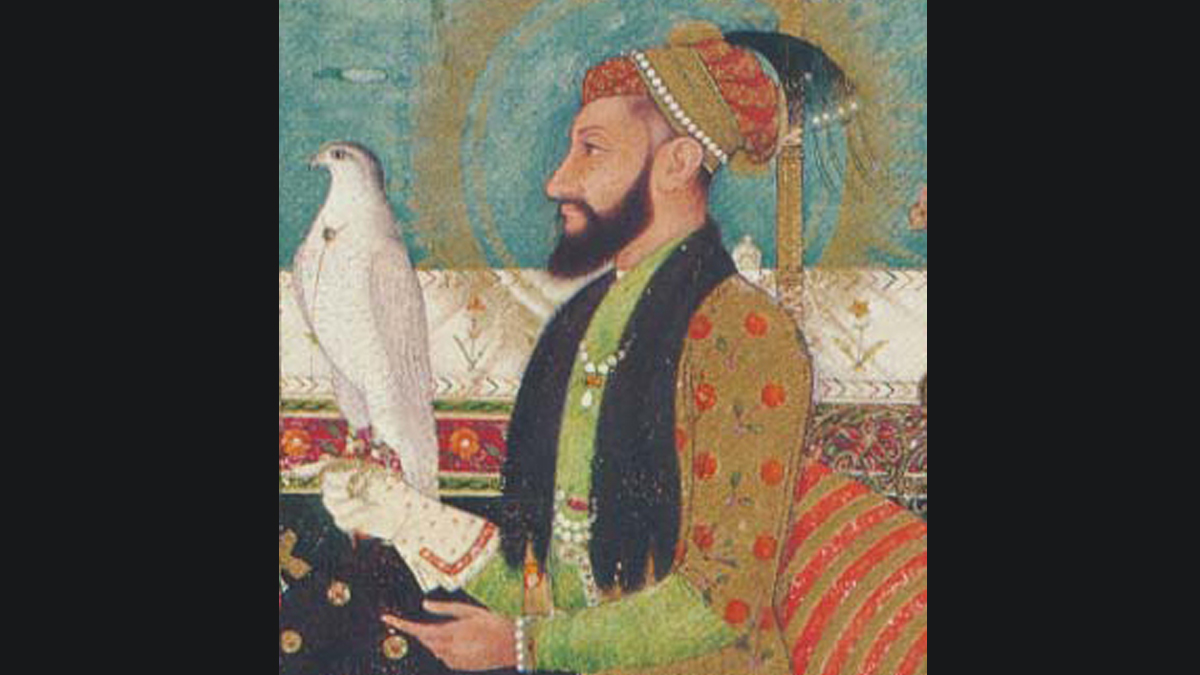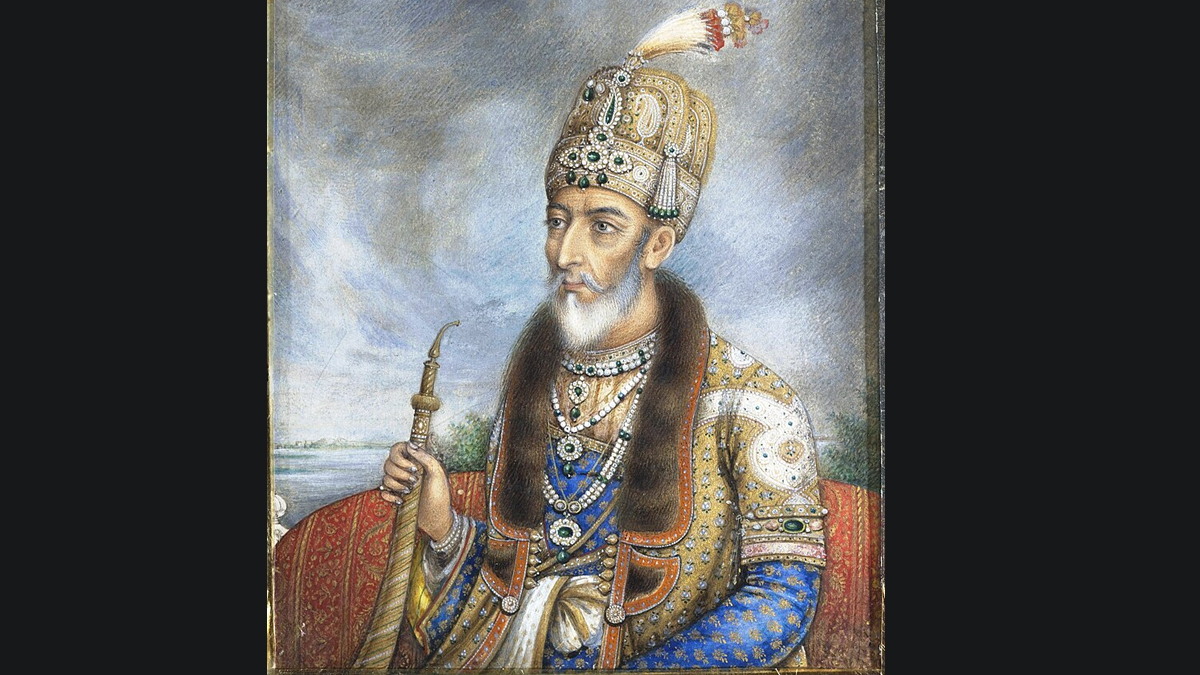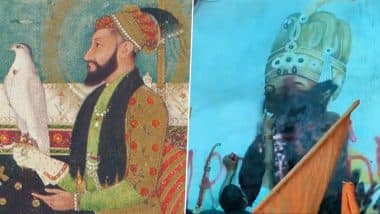Mumbai, April 18: In a historic confusion, members of the Hindu Raksha Dal defaced a portrait of the last Mughal emperor, Bahadur Shah Zafar, after mistaking it for Aurangzeb's at Ghaziabad Railway Station by spraying it with black paint on Friday, April 18. A video of the act has gone viral on social media, showing members targeting the artwork, which is part of the station's cultural decor.
Pushpesh Raman Tripathi, Divisional Railway Manager (DRM) of the Delhi Division, clarified that the painting was mistakenly believed to be of Aurangzeb. 슬롯사이트ЬIt is not right to deface public property, and action will be taken accordingly,슬롯사이트� he said. Railway authorities have launched an investigation and assured that strict action will be taken against those involved in the vandalism. In this article, Latestly brings you the actual pictures of the two Mughal emperors.슬롯 머신 사이트 추천Aurangzeb Painting Blackened at Ghaziabad Railway Station? Hindu Raksha Dal Activists Deface Bahadur Shah Zafar슬롯사이트Щs Mural, Mistaking Him for Aurangzeb (Watch Videos).
Bahadur Shah Zafar's Mural Defaced in Ghaziabad
рд╕реНрдЯреЗрд╢рди рдкрд░ рдкреЗрдВрдЯрд┐рдВрд� 2016 рдореЗрд� рджрд┐рд╢рд╛ рдлрд╛рдЙрдВрдбреЗрд╢рди рдХреА рдУрд░ рд╕реЗ рдкреЗрдВрдЯ рдХреА рдЧрдИ рдереА рдЬрд┐рд╕реЗ рдЙрджрд┐рддрд� рддреНрдпрд╛рдЧреА рдиреЗ рдкреЗрдВрдЯ рдХрд░рд╛рдпрд� рдерд╛ рдЙрдирдХреЗ рдореБрддрд╛рдмрд┐рд� рдпреЗ рдкреЗрдВрдЯрд┐рдВрд� рдмрд╣рд╛рджреБрд░ рд╢рд╛рд� рдЬрдлрд� рдХреА рд╣реА рдереА рдХреНрдпреЛрдВрдХрд� рдЙрд╕ рд╡рдХреНрдд рдкреВрд░реЗ рд╕реНрдЯреЗрд╢рди рдХреА рдкреЗрдВрдЯрд┐рдВрд� рдереАрд� 1857 рдХреА рдХреНрд░рд╛рдВрддрд� рдХреА рдереАре� рдЬрд┐рд╕рдореЗрдВ рдмрд╣рд╛рджреБрд░ рд╢рд╛рд� рдЬрдлрд� рдХрд╛ рдЕрд╣рд� рд░реЛрд� рдерд╛ре� рд╣рд╛рд▓рд╛рдВрдХрд� рдЕрдм рд╡реЛ рдпрддрд�슬롯사이트�
슬롯사이트� Lokesh Rai (@lokeshRlive)
Mughal Emperor Aurangzeb's Portrait
Aurangzeb (1618슬롯사이트�1707) was the sixth and last powerful emperor of the Mughal Empire, ruling from 1658 until his death in 1707. Known for his military expansion, he brought the empire to its greatest territorial extent, but his reign was also marked by religious intolerance and strict Islamic policies, including the reimposition of the jizya tax on non-Muslims. He is a controversial figure, remembered for temple demolitions and prolonged wars, particularly against the Marathas in the Deccan, which weakened the empire. Aurangzeb died in 1707 and was buried in a modest grave in Maharashtra's Khuldabad. Below is the portrait of Aurangzeb by the Indian painter Bichitr.

All About Last Mughal Ruler Bahadur Shah Zafar and His Portrait
Bahadur Shah Zafar (1775슬롯사이트�1862) was the last Mughal emperor of India and a noted Urdu poet. He ascended the throne in 1837, though his authority was largely symbolic under British rule. Zafar became a prominent figure during the 1857 Revolt, when Indian rebels declared him the symbolic leader of the uprising against British colonial rule. After the rebellion was crushed, he was captured by the British, exiled to Rangoon (present-day Yangon, Myanmar), and died there in 1862.슬롯 머신 사이트 추천Aurangzeb Grave Dispute: NIA Team Visits Mughal Emperor슬롯사이트Щs Tomb in Maharashtra슬롯사이트Щs Khultabad, Keeps Eye on Suspicious Movements.
As a poet, he wrote deeply emotional verses, often reflecting themes of loss, exile, and the decline of the Mughal era. "kitna hai bad-nasib 'zafar' dafn ke liye, do gaz zamin bhi na mili ku-e-yar men (How unfortunate is 'Zafar', that for his burial, Not even two yards of land were found in the beloved's city)," one of his famous shayari reads. Check the Bahadur Shah Zafar below.

The incident is reportedly linked to rising protests over the Aurangzeb tomb in Maharashtra's Chhatrapati Sambhaji Nagar (formerly Aurangabad), which have intensified following the release of the Marathi film "Chhava", based on Maratha warrior Chhatrapati Sambhaji Maharaj.
(The above story first appeared on LatestLY on Apr 18, 2025 11:06 PM IST. For more news and updates on politics, world, sports, entertainment and lifestyle, log on to our website latestly.com).













 Quickly
Quickly


















